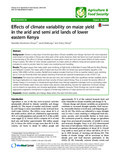| dc.contributor.author | Omoyo, Nyandiko Nicodemus | |
| dc.contributor.author | Wakhungu, Jacob | |
| dc.contributor.author | Oteng’i, Silvery | |
| dc.date.accessioned | 2023-04-24T06:54:21Z | |
| dc.date.available | 2023-04-24T06:54:21Z | |
| dc.date.issued | 2015-06-09 | |
| dc.identifier.uri | https://doi.org/10.1186/s40066-015-0028-2 | |
| dc.identifier.uri | https://agricultureandfoodsecurity.biomedcentral.com/articles/10.1186/s40066-015-0028-2 | |
| dc.identifier.uri | http://ir-library.mmust.ac.ke:8080/xmlui/handle/123456789/2174 | |
| dc.description.abstract | Background
Climate is a key input of rain-fed agriculture. Climate variability and change has been the most important determinant of crop yields in Kenya and other parts of the world. However, there has been not much research on local understanding of the effect of climate variability on maize yields in Arid and Semi arid Lands (ASALs) of lower eastern Kenya counties. The effect of three climatic parameters on maize yields on different temporal and spatial scales was evaluated in order to provide basis for maize crop monitoring and modeling.
Results
This paper argues that maize yields were declining at high levels in Machakos County followed by Kitui, Mwingi, and Makueni Counties. The maize yields Z-values and thus the effect of climate was predominately negative in the period 1994–2008 in all the counties. Rainfall trend analysis revealed that four of the six weather stations were declining up to 3 mm pa. Evidently there was upward warming of annual and seasonal temperatures at rate of 0.03 °C pa.
Conclusion
The study has confirmed that the arid and semi arid counties suffer from significant climate variability which has huge implications on maize yields and food security of lower eastern Kenya. Thus, to counter the adverse effects of climate change, it is necessary to climate-proof agricultural crops through adaptation strategies such as developing maize varieties that tolerate water stress and mature early, practice early planting, increase the awareness of climate change and its impacts on agriculture, and develop appropriate mitigation measures. These findings are crucial in planning appropriate adaptation mechanisms in support of enhancing resilience of maize production and food security. | en_US |
| dc.language.iso | en | en_US |
| dc.publisher | Agriculture & Food Security | en_US |
| dc.subject | Effects of climate variability on maize yield in the arid and semi arid lands of lower eastern Kenya | en_US |
| dc.title | Effects of climate variability on maize yield in the arid and semi arid lands of lower eastern Kenya | en_US |
| dc.type | Article | en_US |

